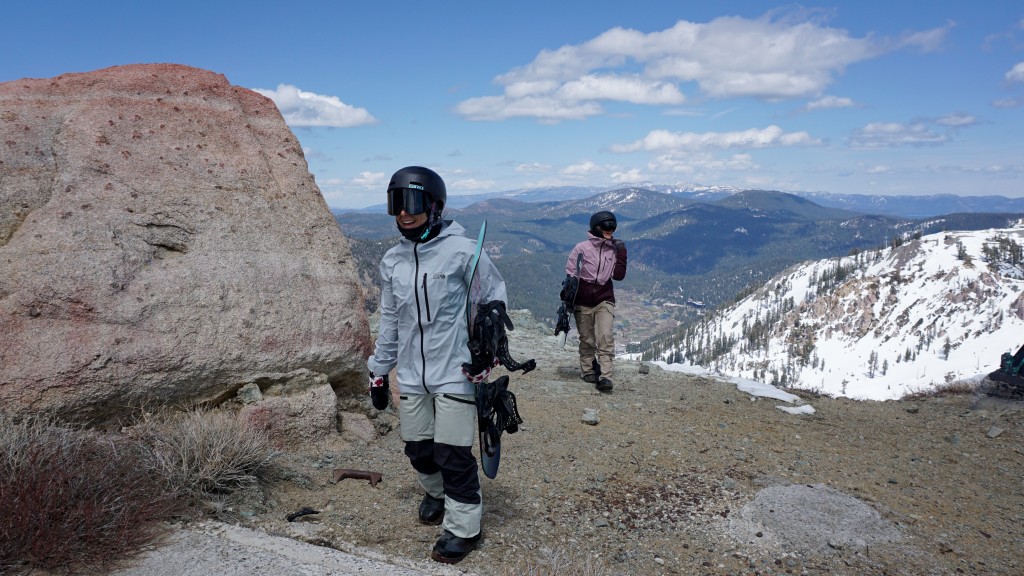Waterproofness isn't the only aspect of a rain jacket that matters. Much more goes into making a jacket pleasant to wear, and we tested it all. We took these coats everywhere with us to gather real-life perspectives of everyday use in actual conditions. We also pushed their limits in the lab to find their breaking points. Here's how we did it.
Water Resistance
As the most important aspect of a rain jacket, we thoroughly tested water resistance out in the field and in the lab with multiple tests. At any sign of wet weather, we grabbed a jacket and headed out the door. We spent hours hiking in everything from a light drizzle to full-on tropical storms to see how these jackets performed in the field. Besides the time spent outdoors in the rain, we also designed a few lab tests to compare how each jacket performed under controlled circumstances next to its competitors.
We spent close to 10 hours in the shower with these rain jackets on, testing how long it took for the water to penetrate and dampen our shirt underneath. We tested the coverage of each hood, as well as how efficiently the hood and cuffs could be tightened down to keep out moisture. We also put paper towels in the pockets to test if important items like keys and a phone would stay dry inside. In a separate test, we laid each jacket flat and poured 8 ounces of water over the zipper and a seam to evaluate the zippers' water resistance. Our final water resistance test was spraying each jacket with water, letting it sit, and checking at intervals to see when the fabric started taking up water.
Breathability
We field-tested the jackets when hiking, snowboarding, on neighborhood walks, biking, and backpacking to see how each jacket did at different intensity levels. We did the same walk when the temperature was between 65-70 degrees Fahrenheit, keeping vents closed until the same point to see how the fabric breathed and then opening the vents on those with this feature to see how quickly the vents dumped heat and moisture.
Comfort and Mobility
Comfort and mobility are other important, multi-faceted considerations when choosing a piece of outerwear. If a jacket is not comfortable, are you going to want to wear it? To test comfort, we had friends wear the jackets to get well-rounded opinions and to see how each fit different body types. We also wore each jacket while doing different activities to see how well they moved during different types of motion. Hiking, snowboarding, backpacking, skating, biking, strolling around town, walking the dogs, and unloading groceries, these jackets got put through their paces in a wide range of activities to see how comfortable they really were.
We also did a set of specific stretches in each jacket to evaluate whether the body, hood, arms, shoulders, or hemline restricted motion or exposed body parts to precipitation. We wore them against bare arms to evaluate the comfort of the inner fabric, cuffs, and neck. We layered them over insulating garments to see how well they worked in chilly conditions. We endlessly fiddled with the features, assessing how easy the pit zips were to do up, how smoothly the zippers ran, tightening and loosening drawcords and velcro to see how easy each jacket was to adjust.
Weight and Packability
Weight and packability can come into play for choosing a rain jacket, especially for those looking for a good lightweight option for travel or for activities like backpacking when a few ounces can add up pretty quickly. With this in mind, we independently weighed each jacket on a finely tuned scale to see how much it weighed. All jackets tested were a size small. We also packed each jacket into its stow pocket — or tightly rolled it if it lacked this feature — and then measured them to assess the volume. We packed them into suitcases, hiking backpacks, backpacking backpacks, and in our work bag and took them everywhere, whether or not we thought we would need them, to see how well they actually fit into a bag. We also packed and unpacked them from their stow pockets as often as possible to assess how easily they packed away, determining if we would actually use the stow pocket or if it was too much effort.
Durability
We wore these jackets day in and day out for months. We hiked with a backpack on to check for signs of wear or abrasion. We pulled and twisted at the seams of each to see if they would tear under pressure. We did a rapid repetitive use test on each zipper. We yanked on zippers, drawcords, and velcro. We thoroughly researched components and scrutinized the materials and construction for flaws and potential weak points. We were not gentle on these jackets and put them through their paces to see if they would hold up.
Through extensive testing and analysis and countless hours spent in each rain jacket, we've taken the guesswork out of purchasing this essential gear. With the information provided in this review, you can confidently choose a jacket that best suits your needs, whether you're embarking on an epic backcountry adventure or merely don't want to let a little drizzle keep you indoors. Regardless of the situation, there's a rain jacket available to keep you dry when the weather threatens to disrupt your plans.







